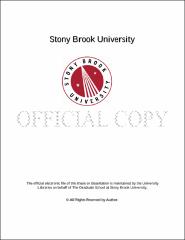| dc.identifier.uri | http://hdl.handle.net/11401/77275 | |
| dc.description.sponsorship | This work is sponsored by the Stony Brook University Graduate School in compliance with the requirements for completion of degree. | en_US |
| dc.format | Monograph | |
| dc.format.medium | Electronic Resource | en_US |
| dc.language.iso | en_US | |
| dc.publisher | The Graduate School, Stony Brook University: Stony Brook, NY. | |
| dc.type | Thesis | |
| dcterms.abstract | With the advancement of affective computing technologies, spontaneous and complex emotions that were difficult or even impossible to recognize in the past are rapidly becoming the focus of many research. One intriguing example of these non-basic emotions is drug craving, a sophisticated concept which neuroscientists have studied for a long time. Nevertheless, it is not yet known whether craving is accompanied by a characteristic expressive behavior when it occurs, and only little work has been done on exploring the relationship between craving and facial expressions. In this thesis, we assume that drug-related stimuli can induce craving-related emotional states in drug users, and study the neurobiological and expressive behavior during these states by means of event-related potential (ERP) analysis and facial expression recognition. We design a passive image viewing task where cocaine users and control subjects watch neutral, drug-related, and non-drug emotional images. We record both electroencephalography (EEG) signals and the frontal face in real time to acquire a dataset that contains the subjects' response to multiple emotional cues. We first aim to establish a baseline y showing that there is a meaningful difference in ERP values between the emotional categories. Individuals with cocaine use disorder (CUD) are expected to display higher magnitude of ERP for cocaine-related cues that for neutral cues. We show that, although to a weaker degree than previous studies, cocaine users react somewhat differently from healthy individuals when exposed to drug stimuli. After that, we use person-specific tracking algorithm to register various facial points of interest. We extract geometric and appearance features from the tracked points and shape ot build feature vectors that can capture the possible occurrence of craving-related behavior. We use several methods of classification and try to distinguish drug cue-induced facial response from other facial expressions. Finally, we discuss the limitations of the current task design and the video dataset. Our results on ERP and facial activity show that our search for the possible expressive behavior correlated with craving is still inconclusive. We propose how the experiment could be improved in order to set a starting point for future research and make the task of facial expression recognition easier. | |
| dcterms.available | 2017-09-20T16:52:20Z | |
| dcterms.contributor | Samaras, Dimitris | en_US |
| dcterms.contributor | Zelinsky, Gregory | en_US |
| dcterms.contributor | Das, Samir. | en_US |
| dcterms.creator | Choi, Hojin | |
| dcterms.dateAccepted | 2017-09-20T16:52:20Z | |
| dcterms.dateSubmitted | 2017-09-20T16:52:20Z | |
| dcterms.description | Department of Computer Science. | en_US |
| dcterms.extent | 50 pg. | en_US |
| dcterms.format | Application/PDF | en_US |
| dcterms.format | Monograph | |
| dcterms.identifier | http://hdl.handle.net/11401/77275 | |
| dcterms.issued | 2014-12-01 | |
| dcterms.language | en_US | |
| dcterms.provenance | Made available in DSpace on 2017-09-20T16:52:20Z (GMT). No. of bitstreams: 1
Choi_grad.sunysb_0771M_12086.pdf: 1138869 bytes, checksum: 693f859c649c23a45a0a0003593038e5 (MD5)
Previous issue date: 1 | en |
| dcterms.publisher | The Graduate School, Stony Brook University: Stony Brook, NY. | |
| dcterms.subject | Cocaine addiction, Emotion recognition, Facial expression, Late positive potential | |
| dcterms.subject | Computer science | |
| dcterms.title | Exploring the ERP and Facial Response to Cocaine and Emotional Cues | |
| dcterms.type | Thesis | |

